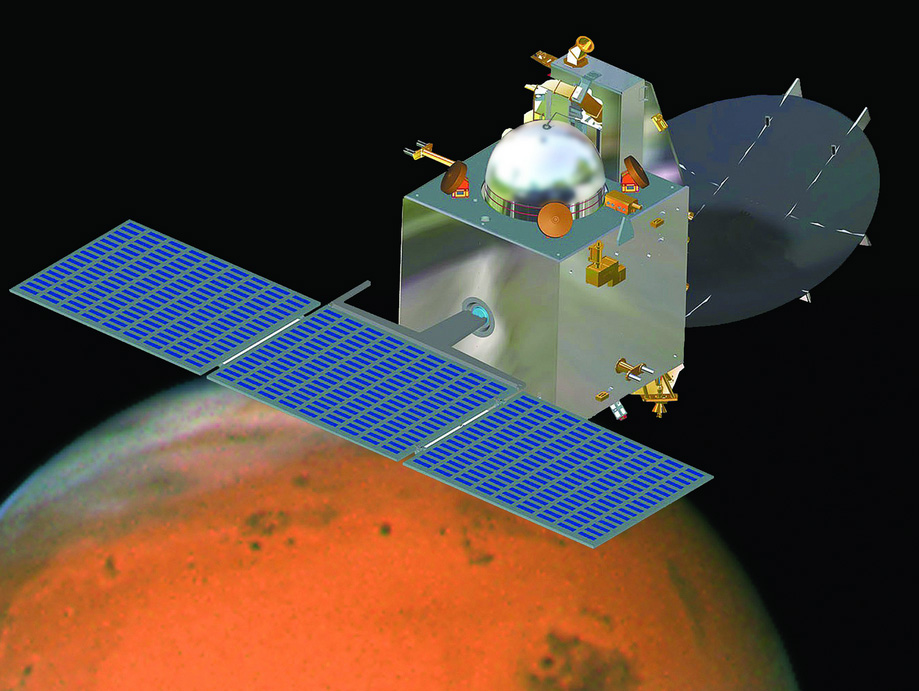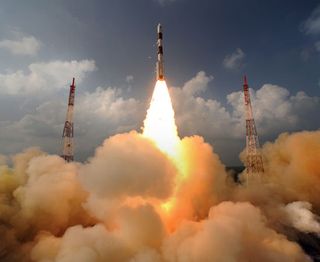India's First Mars Probe Begins Journey to Red Planet

India's first robotic Mars probe set sail for the Red Planet Saturday (Nov. 30) with a vital rocket burn to catapult the spacecraft out of the realm of Earth's gravity and into interplanetary space.
The Mars Orbiter Mission, India's first Mars probe, is due to enter orbit around the Red Planet on Sept. 24, 2014, two days after NASA's MAVEN Mars probe arrives.
Saturday's crucial maneuver was timed for the precise moment necessary to send the spacecraft toward Mars, and it had to go off without a hitch.
India's space agency said the orbiter's burn was successful, with the spacecraft's main engine firing more than 22 minutes starting at 1919 GMT (2:19 p.m. EST) to gain speed and break free of Earth's gravitational influence. [See photos from India's first Mars mission]
"Following the completion of this maneuver, the Earth orbiting phase of the spacecraft ended. The spacecraft is now on a course to encounter Mars after a journey of about 10 months around the sun," the Indian Space Research Organization said in a written statement.
The $72 million mission has a trip of more than 400 million miles (643.7 million kilometers) ahead of it. The probe will fly halfway around the sun while moving out toward the orbit of Mars, intercepting the Red Planet Sept. 24 for another major rocket maneuver to place itself into orbit.
If the probe arrives successfully, India's space agency will become the fourth entity to have a mission reach Mars. The United States, Russia and the European Space Agency have already done it. [Spaceflight Now Photos: India's Mars Mission Before Launch]

The Mars Orbiter Mission launched Nov. 5 on India's Polar Satellite Launch Vehicle, the smaller but more reliable of the nation's two rockets.
Get the Space.com Newsletter
Breaking space news, the latest updates on rocket launches, skywatching events and more!
The PSLV was not powerful enough to put the nearly 1.5-ton spacecraft on a direct trajectory to Mars. Instead, engineers devised a departure profile that put the probe into an oval-shaped orbit around Earth and used its on-board engine to gain speed and altitude throughout November, eventually generating enough energy to escape the planet's grasp.
Indian controllers used the time to activate the spacecraft's systems and research payloads, including the mission's camera which snapped a photo of Earth. All systems on the spacecraft are performing well, according to ISRO.
The decision to launch on the PSLV removed the risk of launching on India's larger failure-prone Geosynchronous Satellite Launch Vehicle, which could have put the mission immediately on the path to Mars.
But it also raised other risks.
The probe repeatedly passed through Earth's Van Allen radiation belts. Indian officials mitigated the threat by beefing up the craft's computers with radiation shielding.
And it meant the probe had to carry more propellant, leaving less room for scientific instruments and decreasing the fuel left over to survey Mars once it arrives there.
The Indian mission carries about 33 pounds, or 15 kilograms, of scientific instrumentation.
Operating from a perch taking the spacecraft from just above the Martian atmosphere to a peak altitude of nearly 50,000 miles (80,467 km), the Mars probe will observe the planet with five science instruments, gathering data on the history of the Martian climate and the mineral make-up of its surface.
The mission carries a color imaging camera to return medium-resolution pictures of the Martian surface, a thermal infrared spectrometer to measure the chemical composition of the surface, and instruments to assess the Mars atmosphere, including a methane detector.
Scientific assessments of methane in the Martian atmosphere have returned mixed results.
Methane is a potential indicator of current microbial life on Mars, but some types of geologic activity can also produce trace levels of the gas.
Following up on detections from ground-based telescopes and Europe's Mars Express orbiter, NASA's Curiosity rover measured no methane in the Martian atmosphere when it sucked air into its internal instrument suite on several occasions since landing in August 2012.
But India says the Mars Orbiter Mission's prime purpose is technological, not scientific.
"First and foremost, India should be able to orbit a spacecraft around Mars," ISRO chairman K. Radhakrishnan told India's NDTV television network before the mission's launch. "We are moving from Earth's orbit to the orbit of Mars through a long cruise phase around the sun."
The mission's ground team plans several course-correction burns over the 10-month trip to Mars, with the first set for Dec. 11. The midcourse maneuvers will tweak the probe's trajectory to arrive at Mars at the right time and in the correct position in September 2014.
You can follow India's Mars probe with SPACE.com partner Spaceflight Now via the Mars Orbiter Mission Mission Status Center here.

Follow Stephen Clark on Twitter: @StephenClark1.Copyright 2013 SpaceflightNow.com, all rights reserved.
Join our Space Forums to keep talking space on the latest missions, night sky and more! And if you have a news tip, correction or comment, let us know at: community@space.com.
Stephen Clark is the Editor of Spaceflight Now, a web-based publication dedicated to covering rocket launches, human spaceflight and exploration. He joined the Spaceflight Now team in 2009 and previously wrote as a senior reporter with the Daily Texan. You can follow Stephen's latest project at SpaceflightNow.com and on Twitter.

